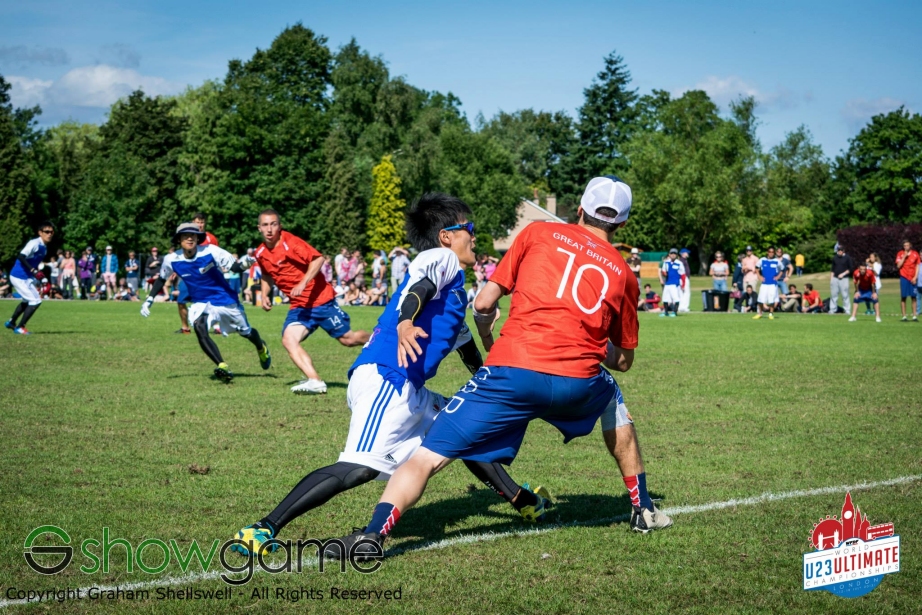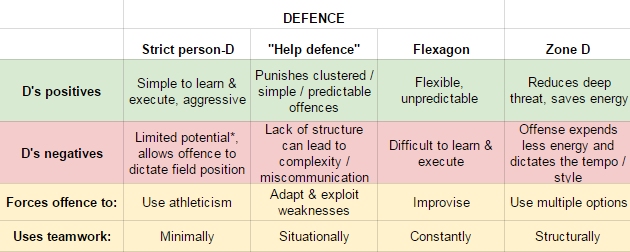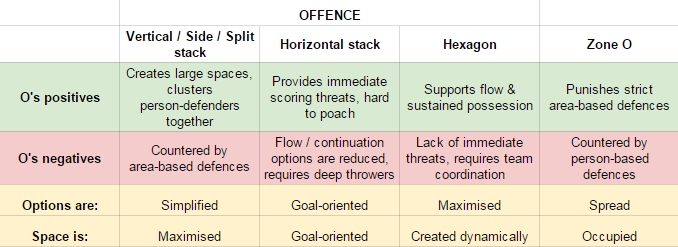Advanced Flex – Part II: Communication
(c) Felix Shardlow v.0.2 4th May 2016
Last updated: 9th July 2021
Also available in French / en Français
Part of a series:
Advanced Flex – Principles in Detail
Advanced Flex Part I: Counter-Strategies
Advanced Flex Part II: Communication
Advanced Flex Part III: The Stall 3 Game-Changer
Good communication within a team is essential for good teamwork, combined with trust in your team mates communications. When you receive communication from a team mate, you should immediately act on it, and then re-assess the situation. Very rarely should communication from a team mate be assessed before being put into action.
Communication should be near-constant during a point of Flex, when team mates are within range of each other. If any of the principles are being disobeyed then there should be a lot of noise on the field – if an offensive player is unmarked, all defenders should know about it and be working together constantly to remedy the situation. If it’s becoming possible to surround the opposition, or if their positioning indicates a switch may be possible soon, communication should already be happening.
The 3 ways to communicate in Flex
- Eye-contact – opens the channel of communication between two defenders
- Gesticulation – directs attention to a particular area or person
- Vocalisation – gives detailed information or instructions
Eye-contact between defenders should happen whenever they have the opportunity – usually when their marks are not moving and they are re-assessing the situation. A moment of eye-contact has multiple immediate benefits:
- Communication channel is opened. If there is anything you or your team mate wish to communicate to each other, you have each others attention so are able to do so, through facial expressions, gesticulation, or vocalisation. A neutral look saying “everything is OK” is useful in itself.
- Each defender gets knowledge of their teammate’s position, and the position of their teammate’s mark. They also know that their teammate is aware of their situation – which pre-empts opportunities for switches or sandwiches.
- Defenders are put “on the same page”. The chance for miscommunication is minimised, and a good base for teamwork is established.
Gesticulation conveys more specific information, and can be recognised by many defenders at the same time. Usually the meaning of any gesticulation is self-explanatory when combined with player movement – here are some examples:
- Pointing to an offence player or players – depending on the context, this can either mean you are marking them, or that your team mate should mark them. Pointing to two or three players (by using two or three fingers) is a quick way of initiating a surrounding setup with teammate(s).
- Open-hand gesturing can be used to indicate what area you are covering in a surrounding setup, and to move defending team mates around to improve coverage.
- During a switch, pointing is best used to indicate the player you are leaving (who your team mate should immediately mark tightly), but can also be used to indicate the player you are picking up. Your movement serves as an instant clarification – the fact that you are making an effort to communicate indicates to your teammate that they should react to your movement.
Vocalisation is the most flexible form of communication, and can be reach all defenders within earshot, essential when they are occupied or when their back is turned. Any information conveyed vocally also carries with it information about where on the field the shout is coming from, and the tone / volume of the shout indicates the level of urgency. Shouts should be accompanied by gesticulation where possible, to give more specific information to team mates who have you in their field of view, or who turn to look when they hear the shout. Here are some shouts which have proved to be useful in Flex:
- “[name]” / “yours” / “mine” / “I’m here” / “you’re there” – most direct way to get a teammates’ attention is to shout their name, when combined with gesticulation the intention is usually clear. Other short phrases are used to clarify basic responsibilities quickly, and to let your teammates know you are prepared to switch or surround.
- “1”, “2”, “3” etc – indicates the number of offensive players you are covering. If the player you are marking is isolated or you wish to stick 1-to-1 to them for any other reason, a shout of “1” will clarify this with your team mates. If two offensive players are positioned in close proximity, a shout of “2” indicates the defence can form a two person bracket, and should be echoed with a “2” shout from the other defender. Similarly, a shout of “3” or more should be echoed by the other defenders who are involved in the surrounding setup.
- “Count” – if defenders are being too quiet in a surrounding setup, and you are looking for reassurance that they are on the same page, “count” encourages them to assess the situation and shout a number (even if they decide on “1”).
- “Surround” – as soon as you notice an opportunity to surround, bring it to everyone’s attention.
- “Push” – used to move nearby defenders away from you. This is useful when you realise you are both covering the same space, when the surrounding setup needs to be adjusted, or when you see an unmarked offensive player the other side of a team mate. When you hear “Push”, you should initially move directly away from where the voice came from, before reassessing the situation. Example animation here.
- “Pull” – the opposite to ‘Push’, use “Pull” when you want defenders to come towards you, or to an area near you. This is useful when you find yourself covering two or more players, or when you can see an unmarked offensive player nearby. When you hear “Pull”, you should initially move towards where the voice came from, before reassessing the situation. Example animation here.
- “Left/right” – can be used to move a team mate when you are out of their line of sight. If a team mate has their back to you, your left is their left, so directing them with left/right shouts is relatively straightforward. When they are facing you, gesticulation is more effective. Left/right shouts are also useful for communicating with the force.
- “Switch” – a ‘switch’ call is common and used when two defenders wish to swap their marks. Switches are ideally called when you know (a) who your new mark will be, and (b) that your old mark will be covered, and often the movement to cover a cut will happen before the utterance of “switch”. Silent switches should be avoided, unless they are pre-empted.
Sideline
Most communication in Flex is done on-field because everything happens so quickly and dynamically. There are a number of ways the sideline can help:
- Up shouts for every pass. The length and tone of the “Up” shout can help convey the type of pass made. This is very useful for players who aren’t in a position to actually see the pass being made – it lets them know the angle of attack is changing, the stall count is resetting (see Advanced Flex Part IV: The Stall-3 Game Changer), and that the disc is momentarily in the air so an immediate throw is not possible (a good opportunity to check disc position).
- Identify and alert players to any situations where an offensive player is left unmarked, a surrounding setup is unbalanced, or a defender is marking two players.
- The thrower’s focus – let the defender nearest to where the thrower is focusing their attention know that the thrower is looking, so they can be extra vigilant. Shout the name of the defender of the next player you think will be looked at.
- High stall counts – lots of noise & “here it comes” from the sideline to let defenders know a pass is coming very soon, so they should tighten up to their mark and be ready for the unexpected. See Advanced Flex Part III: The Stall 3 Game-Changer to learn more about how the defence should change the way they are marking depending on the stall count.
Part of a series:
Advanced Flex – Principles in Detail
Advanced Flex Part I: Counter-Strategies
Advanced Flex Part II: Communication
Advanced Flex Part III: The Stall 3 Game-Changer








